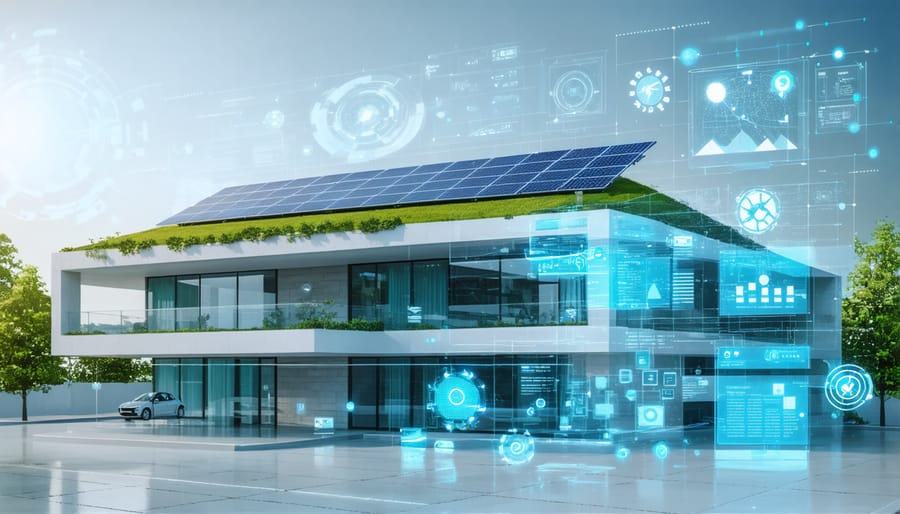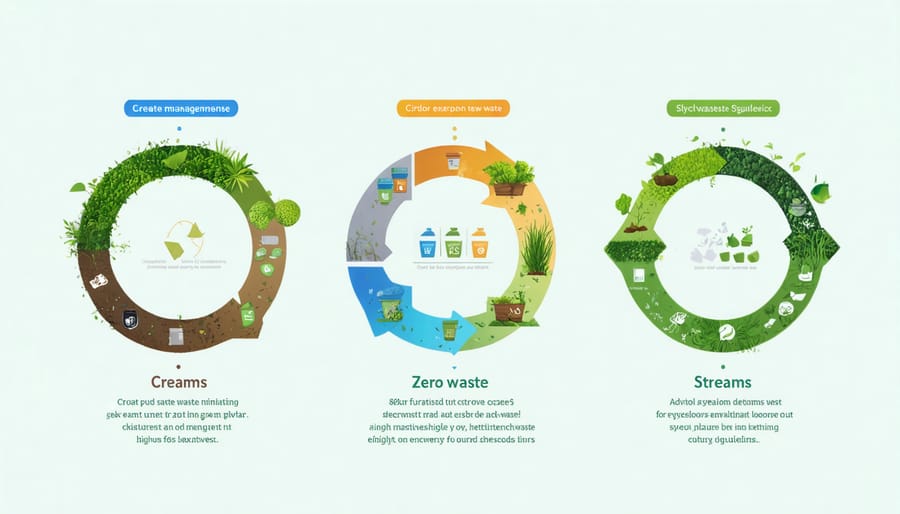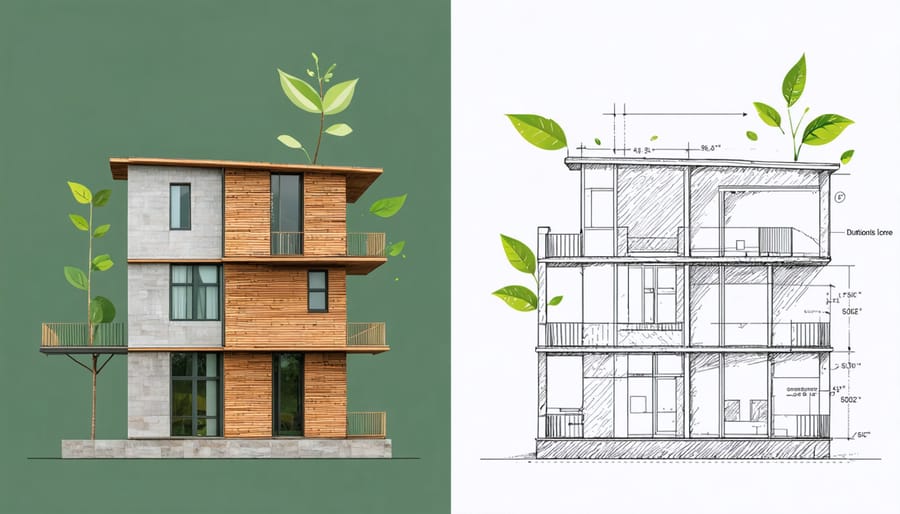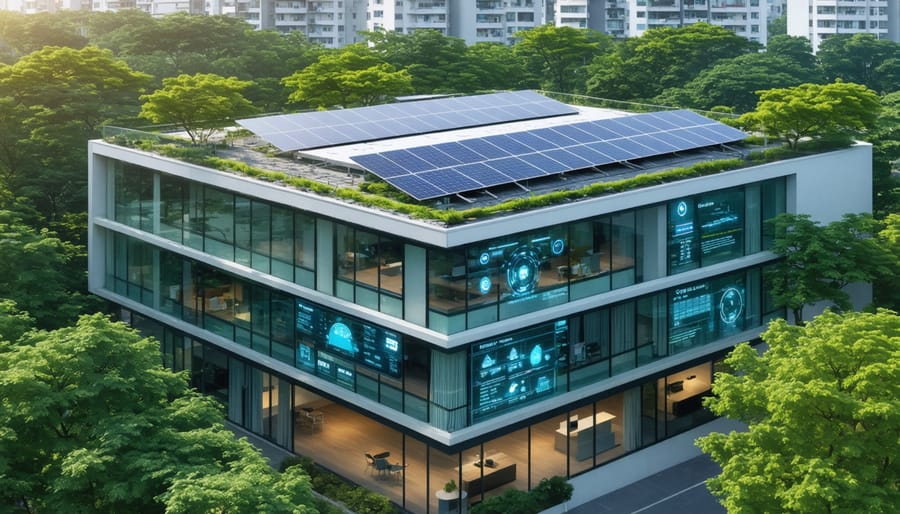In today’s high-stakes property management landscape, implementing robust sustainability principles isn’t just environmental stewardship—it’s a strategic imperative where sustainability drives profit and performance across the entire asset lifecycle. The six foundational principles of sustainability represent a comprehensive framework that transforms conventional building operations into resource-efficient, future-ready assets.
These principles—resource optimization, energy efficiency, waste reduction, sustainable materials, occupant wellbeing, and ecological integration—form the cornerstone of modern property management. When systematically implemented, they deliver measurable returns through reduced operational costs, enhanced asset value, and improved tenant satisfaction rates.
Leading property managers and facility operators worldwide are leveraging these principles to achieve remarkable results: 30-50% reductions in energy consumption, 40% decreases in water usage, and significant improvements in building performance metrics. This practical guide explores each principle in detail, providing actionable strategies backed by industry case studies and quantifiable outcomes.
For construction professionals and property stakeholders seeking to optimize their assets’ environmental and financial performance, understanding and implementing these six principles is no longer optional—it’s essential for maintaining competitive advantage in an increasingly sustainability-focused market.
Energy Efficiency and Resource Conservation
Smart Energy Management Systems
Modern building management demands sophisticated energy control systems, and smart building technologies are leading this transformation. By implementing automated systems and Internet of Things (IoT) solutions, facilities can achieve significant energy savings while maintaining optimal comfort levels for occupants.
These intelligent systems utilize a network of sensors and controllers to monitor and adjust lighting, HVAC, and other building systems in real-time. Advanced algorithms analyze occupancy patterns, environmental conditions, and energy consumption data to make automated adjustments that maximize efficiency.
Key components typically include:
– Occupancy-based lighting controls
– Smart thermostats with learning capabilities
– Energy consumption monitoring and reporting
– Predictive maintenance systems
– Integrated building automation platforms
Industry data shows that buildings implementing these systems typically achieve 20-30% reduction in energy consumption. For example, the Cooper Union Building in New York reduced its energy costs by 24% after installing an integrated energy management system that coordinates HVAC, lighting, and power distribution.
The ROI for these systems usually materializes within 2-3 years, making them an increasingly attractive investment for property managers committed to sustainable operations.

Water Conservation Strategies
Water conservation strategies in sustainable buildings focus on implementing advanced fixtures and monitoring systems that maximize efficiency while minimizing waste. Low-flow faucets, dual-flush toilets, and sensor-operated fixtures can reduce water consumption by up to 30% compared to traditional installations. Smart water meters and leak detection systems provide real-time monitoring, enabling facility managers to identify and address inefficiencies promptly.
Greywater recycling systems represent another crucial component, collecting and treating water from sinks, showers, and washing machines for non-potable applications like irrigation and toilet flushing. These systems can reduce potable water demand by 30-50% in commercial buildings.
Advanced irrigation systems incorporating soil moisture sensors and weather-based controllers optimize outdoor water use. These technologies adjust watering schedules based on real-time conditions, preventing overwatering and reducing landscape water consumption by up to 40%.
Regular maintenance and monitoring of water systems are essential for sustained efficiency. Building managers should implement comprehensive water management plans that include periodic audits, fixture maintenance schedules, and staff training programs. Data collected through monitoring systems can inform decision-making and validate conservation efforts, demonstrating ROI through reduced utility costs and improved environmental performance.

Waste Reduction and Management
Implementing Effective Recycling Programs
Implementing effective recycling programs in construction projects requires a systematic approach that begins with comprehensive waste auditing and sorting protocols. Start by establishing clearly marked collection points for different materials: metals, concrete, wood, plastics, and hazardous materials. These stations should be strategically placed throughout the construction site to maximize accessibility and compliance.
Train all personnel on proper waste segregation procedures and maintain detailed documentation of waste streams. Consider implementing a color-coding system for different waste categories to simplify the sorting process. Partner with certified recycling facilities that specialize in construction waste and can provide tracking metrics for sustainability reporting.
For optimal results, incorporate reverse logistics planning into your waste management strategy. This involves coordinating with suppliers to take back excess materials and packaging, reducing overall waste volume. Regular monitoring and reporting of recycling rates help identify areas for improvement and demonstrate compliance with sustainability goals.
Advanced practices include establishing on-site crushing facilities for concrete and masonry waste, implementing digital waste tracking systems, and creating incentive programs for achieving recycling targets. These measures not only support environmental sustainability but also contribute to cost savings through reduced disposal fees and potential material resale opportunities.
Zero-Waste Initiatives
Zero-waste initiatives in property management focus on systematic approaches to eliminate waste throughout a building’s lifecycle. The process begins with comprehensive waste audits to identify primary waste streams and opportunities for reduction. Successful implementations typically include multi-stream recycling systems, composting programs for organic waste, and partnerships with specialized recycling facilities for handling construction and demolition materials.
Property managers can achieve significant waste reduction by implementing digital documentation systems, reducing paper waste, and establishing procurement policies that prioritize vendors offering minimal packaging or take-back programs. Material recovery facilities (MRFs) play a crucial role in processing recyclables, while on-site compactors and balers help optimize waste management operations.
Key strategies include implementing tenant education programs, installing clearly marked waste sorting stations, and developing waste tracking systems to measure progress. Many properties have achieved 70-90% waste diversion rates through these methods. Advanced initiatives incorporate circular economy principles, such as using recycled materials in renovations and establishing material exchanges between properties.
To ensure success, property managers should set clear targets, regularly monitor performance metrics, and engage stakeholders through consistent communication and incentive programs.
Sustainable Materials and Maintenance
Green Building Materials
The selection of sustainable building materials forms a crucial foundation for successful green building initiatives. Industry leaders are increasingly prioritizing materials that minimize environmental impact while maximizing building performance. Key considerations include recycled content, locally sourced materials, renewable resources, and products with environmental product declarations (EPDs).
Sustainable materials like mass timber, recycled steel, and low-carbon concrete offer significant environmental benefits while maintaining structural integrity. These materials typically feature lower embodied carbon, reduced waste generation, and enhanced lifecycle performance. For instance, mass timber construction can reduce carbon emissions by up to 40% compared to traditional steel and concrete structures.
Moreover, sustainable materials often contribute to improved indoor air quality through low VOC emissions and natural properties. Rapidly renewable materials such as bamboo and cork provide excellent alternatives to traditional hardwoods, while recycled content in insulation and finishing materials helps reduce landfill waste. When properly specified, these materials can also contribute to LEED certification points and other green building standards, enhancing both environmental performance and property value.

Eco-friendly Maintenance Protocols
Effective maintenance protocols play a crucial role in sustaining a building’s environmental performance throughout its lifecycle. The implementation of predictive maintenance strategies, utilizing IoT sensors and data analytics, enables facility managers to address issues before they escalate into major repairs, reducing resource waste and environmental impact.
Green cleaning practices form the cornerstone of eco-friendly maintenance, incorporating biodegradable cleaning agents and microfiber technology to minimize chemical usage and water consumption. These methods not only protect indoor air quality but also reduce the environmental footprint of routine maintenance operations.
Regular energy audits and systems optimization should be conducted quarterly, focusing on HVAC efficiency, lighting systems, and building envelope integrity. This proactive approach helps identify energy leaks and optimization opportunities while extending equipment lifespan.
Water conservation measures, including smart irrigation systems and leak detection protocols, must be integrated into maintenance routines. Additionally, implementing a waste management hierarchy that prioritizes reduction, reuse, and recycling helps minimize maintenance-related waste.
Documentation and training programs ensure maintenance staff understand and consistently apply sustainable practices, creating a culture of environmental stewardship in facility operations.
Indoor Environmental Quality
Indoor Environmental Quality (IEQ) stands as a crucial principle of sustainable construction, directly impacting occupant health, productivity, and overall well-being. This principle encompasses several key components that work together to create optimal indoor conditions while maintaining energy efficiency.
At its core, IEQ focuses on maintaining superior air quality through effective ventilation systems and the careful selection of low-emission materials. Modern HVAC systems with advanced filtration capabilities remove airborne pollutants, while CO2 sensors monitor and adjust ventilation rates based on occupancy levels. The specification of low-VOC paints, adhesives, and furnishings further contributes to maintaining healthy indoor air.
Natural lighting plays a vital role in IEQ strategy, with studies showing its significant impact on occupant productivity and mental health. Strategic window placement, light shelves, and automated daylight harvesting systems maximize natural light penetration while managing glare and heat gain. This approach not only enhances visual comfort but also reduces reliance on artificial lighting.
Thermal comfort represents another critical aspect of IEQ. Advanced building management systems maintain optimal temperature and humidity levels while responding to occupant preferences and external conditions. Zoned HVAC systems allow for personalized comfort control in different areas, improving occupant satisfaction while optimizing energy usage.
Acoustic comfort is increasingly recognized as essential for occupant well-being. Sound-absorbing materials, strategic space planning, and noise control measures help create environments conducive to concentration and productivity. Modern sustainable buildings incorporate these elements while balancing other environmental considerations, such as natural ventilation and open-plan designs.
By prioritizing IEQ, buildings can achieve both sustainability goals and superior occupant experience, leading to increased property value and reduced operating costs.
Community Integration and Social Responsibility
Sustainable construction extends beyond environmental considerations to encompass social responsibility and community integration. Successful projects actively engage with local communities, creating positive social impact while fostering long-term stakeholder relationships. This principle emphasizes the importance of understanding and addressing community needs throughout the project lifecycle.
Construction professionals must conduct thorough social impact assessments before project initiation, identifying potential effects on local employment, cultural heritage, and community well-being. This process involves meaningful consultation with residents, local businesses, and community organizations to gather insights and address concerns proactively.
During construction, implementing local hiring practices and partnering with area businesses helps stimulate the local economy while building community support. Projects should incorporate spaces and amenities that benefit the community, such as public gathering areas, green spaces, or recreational facilities. These features enhance project value while contributing to neighborhood vitality.
Social sustainability also involves ensuring fair labor practices, maintaining workplace safety, and providing professional development opportunities for workers. Companies should establish clear communication channels with stakeholders and maintain transparency regarding project impacts and mitigation measures.
Leading construction firms are increasingly adopting social return on investment (SROI) metrics to quantify their community impact. This includes tracking job creation, local business participation, and community program effectiveness. Regular stakeholder engagement through community advisory boards and feedback mechanisms helps maintain positive relationships and ensures ongoing alignment with community needs.
By integrating social responsibility into project planning and execution, construction professionals can create developments that not only meet sustainability goals but also contribute to community resilience and social cohesion.
Continuous Monitoring and Improvement
Effective sustainability initiatives require rigorous monitoring and continuous improvement to ensure long-term success. This principle emphasizes the importance of establishing measurable metrics, tracking performance, and implementing data-driven adjustments to sustainability strategies.
Organizations should implement comprehensive monitoring systems that track key performance indicators (KPIs) across various sustainability dimensions. These typically include energy consumption, water usage, waste generation, carbon emissions, and resource efficiency. Modern building management systems (BMS) and smart sensors provide real-time data collection capabilities, enabling precise measurement and immediate response to deviations from sustainability targets.
Regular sustainability audits play a crucial role in assessing progress and identifying areas for improvement. These audits should evaluate both quantitative metrics and qualitative aspects, such as occupant satisfaction and community impact. Industry-standard certification programs like LEED, BREEAM, and WELL provide structured frameworks for performance assessment and benchmarking against best practices.
Data analysis and reporting mechanisms should be established to transform collected information into actionable insights. This includes monthly or quarterly performance reviews, trend analysis, and comparison against established sustainability goals. Organizations should also maintain transparent communication with stakeholders about their sustainability performance through regular reports and updates.
Continuous improvement strategies should be embedded within the organization’s operational framework. This involves regular review of sustainability policies, update of action plans based on performance data, and integration of new technologies and practices as they become available. Employee training programs should be regularly updated to reflect new sustainability initiatives and best practices, ensuring consistent implementation across the organization.
Success in sustainability requires a commitment to ongoing measurement, analysis, and adaptation of strategies based on performance data and emerging opportunities for improvement.
The implementation of these six sustainability principles represents a transformative approach to modern property management and construction practices. By embracing these principles, organizations can achieve significant cost savings, enhanced operational efficiency, and improved environmental performance while meeting increasingly stringent regulations. Industry leaders who have adopted these principles report an average of 30% reduction in energy costs and 25% decrease in waste management expenses. As we look toward the future of property management, these principles will become increasingly critical for maintaining competitive advantage and ensuring long-term resilience. Organizations that act now to integrate these sustainability measures will be better positioned to adapt to evolving environmental standards, meet stakeholder expectations, and create lasting value in their property portfolios. The journey toward sustainability is ongoing, but the roadmap provided by these principles offers a clear path forward for construction professionals committed to building a more sustainable future.

